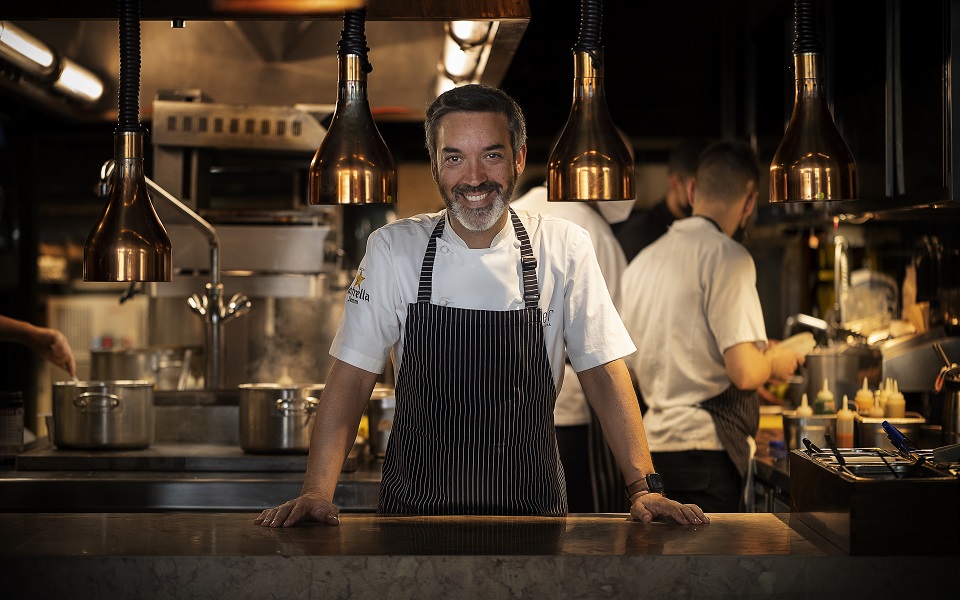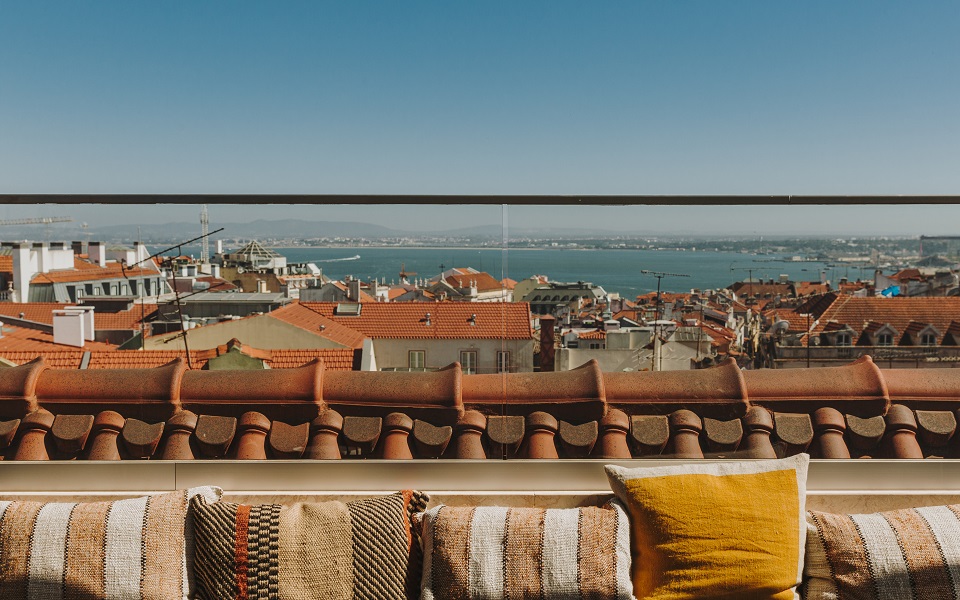Learning Lisbon’s foodie secrets with the Jamie Oliver of Portugal

As new Portuguese restaurant Joia opens in London, Adam Bloodworth visits Lisbon to taste its inspiration
Unless you’ve spent the last decade hiding underneath a yellow tram, you will have noticed that Portugal’s capital Lisbon has become the European city du jour lately. Everyone in your office has a tip for the best pastel de nata, the smartest way to avoid the queue for the scenic tram and for the hippest neighbourhood.
In many ways, now is Lisbon’s sweet spot: investment is flooding in due to the rise in tourism, and that means Lisbonites are opening excellent restaurants, bars and cultural institutions all across town. Each district retains a strong identity in the face of tourism but, like with any city, it can be hard to know where to go that is truly excellent.
I wanted some tips, so following the opening of the Joia Portuguese restaurant in London, I had taken the opportunity to go to Lisbon to meet its famous head chef Henrique Sá Pessoa, the ‘Jamie Oliver of Portugal,’ to discover the places locals love, and the places that inspire Sá Pessoa’s London menu.

In Chiado, Lisbon’s grown-up post code, elegant boulevards lead to smart promenades along the water. Here, thousands of weekend trippers wander glaze-eyed between bakeries, diligently taking photos of their custard tarts. In the balmy early-summer it’s so popular here that I overhear English spoken as much as Portuguese.
To get out of the way of the crowds I dip down the Rue Anchieta and go along an anonymous-looking road that houses Lisbon’s only twice-Michelin-starred restaurants, Alma and Belcanto. I have arrived in Lisbon’s “little stretch of San Sebastian,” as one local puts it.
At Alma, I’m greeted by a closed double-height door, so I press the buzzer and wait out an unnerving pause. Eventually I’m let into a cavernous old room, the mix of air conditioning and stone walls making it ten degrees cooler in here than in the unforgiving heat outside. This old storage area for the Bertrand bookstore next door, the world’s oldest bookstore, is so stately that it feels like I’m dining in a chapel. If a chapel had been cleaned out to get rid of the mustiness then somehow turned into an inexplicably chic restaurant.
A chorus line of intriguing pre-menu dishes arrived, each one offering a different story about provenance and flavour. I cancelled my afternoon plans, as you do when lunch takes four hours. But this was worth it. Each of the dishes boldly provoked conversations about flavour and gave me a true taste of why Lisbon is so ground-breaking right now for gastronomes. Foie gras was served in hearty chunks with apple, granola, beetroot and coffee, then salted cod – de Passoa’s speciality and a Lisbon classic – with coriander, brandade and kale. A suckling pig confit with turnip top puree, picked onions and black pepper was the sort of audacious flavour mash-up de Passoa pulls off with unshatterable confidence.

Henrique Sá Pessoa is riding the wave of Lisbon’s popularity with his new London restaurant. He has launched Joia, a spectacular spot at the Art’otel at the Battersea Power Station, where he offers a whistle stop tour through Lisbon. Giant carabineros prawns, more salted cod (chewy and intense) and a stunning Txuleton black angus forerib. In Lisbon, de Passoa tells me Joia has been booked out most evenings: it is buzzy, but the views of the Battersea Power Station chimneys by night are also the pull. They feel so close you could reach out and snap them off. Treat yourself with a stay at the hotel for access to the rooftop jacuzzi (yes, seriously.)
Back in Chiado, and on the search for more authenticity, and to get away from the Brits, I drunkenly ambled two minutes to Rue Garrett, where de Passoa, over lunch, told me I must visit his favourite bakeries. Castro looks pretty much like any other swish pastel de nata shop, but I was given word that these truly are the best. Workers laid out metre-sized trays filled with tight rows of flaky pastries. They were passed through to the cafe through a hatch that is, to the millimetre, the size of the tray. Castro is very busy, so you run the risk of a fatigued server bagging you a cold pastry, so ask particularly for one that’s warm. Mine had a deep custard filling that was gently sweet, not cloying. The custard is almost waxy, and the flakes of pastry mix with it, creating texture in the chew. Over the road the Alcoa bakery has been family run for generations. There they specialise in all sorts of multi-coloured things that vow to decay even the strongest teeth.
The rooftop bar buzzes into the small hours; people talk of art and social change. I sit on a wall four storeys above the street-level bars and watch the chaos below
A twenty minute sweaty climb uphill and there’s an east London feel in Bairro Alto, which is lauded as one of the hippest neighbourhoods in Lisbon. The district is famous for nightlife, and also its eclectic mix of pastel-shaded buildings so pretty you feel they must be having you on. By day it’s appealing cafe culture; but be warned: by night the bars have a shade of the overpopulated Thai islands about them if you don’t know where to go. With the passing of British bar crawl groups and stag dos, Bairro Alto by night has largely fallen casualty to Lisbon’s popularity. But a few (literally a few) exceptional spots retain the area’s hipster identity that made the district a popular spot to visit before Lisbon’s tourism explosion.
On Rue da Barroca at the Zé dos Bois gallery I’m met by a 50-something artist who guards his rooftop from the drunken masses. Smile, don’t be absolutely trashed, and he’ll let you up for free. At Zé dos Bois, I’m surrounded by the Portuguese and beers are reasonably priced and served in little silver metal glasses. The rooftop bar buzzes into the small hours; people talk of art and social change. I sit on a wall four storeys above the street-level bars and watch the chaos below. Purex, at the far end of the nightlife quarter, is also feverishly fun. Inside, drinkers ask me how I found out about this bar. “Everyone down there is drunk! But we don’t mind you!” they say, gesturing down the road at the tourist bars and taking me under their wing.
I stayed at The Lumiares Hotel in Bairro Alto, a relatively new hotel and a shiny bastion of New Lisbon with a pretty rooftop spot for breakfasts and lazy dinners. My room looked out over the terminus point for the Glória S. Pedro Alcântara tram, one of the steepest routes. From my apartment I watched families queue to pose for selfies in front of the buttercup-yellow vehicles as they rested before slipping back downhill.
A five minute walk away in Príncipe Real, I was in the location of de Passoa’s hipper restaurant, Tapisco, and the Red Frog bar, one of the world’s best. The Davvero restaurant is also closeby, where a French chef formerly of Cipriani cooks excellent Italian food, showing how Lisbon isn’t all about local. In London terms I’m perhaps somewhere like Dalston, if Bairro Alto is Old Street. In Principe Real, it feels even more like true Lisbon: the yelps of British tourists have by now faded well into the distance. There are fabulous buildings displaying the city’s famous mosaics and tiles, some dating to the 16th century, and at any time of day or night locals gather in the park. Lisbonites, out for Saturday afternoon and getting as far away from the overrun Time Out Market as they can, meander from one bar to the next.
To book Joia Battersea visit joiabattersea.co.uk; for The Lumiares visit thelumiares.com
